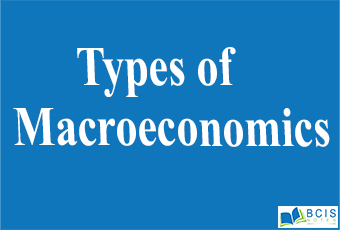
Types of Macroeconomics
Macroeconomics has been divided into three types. They are:
1.Simple Macro-statics:-
Macro-statics deals with the final equilibrium of the economy at a particular point in time.
a. Study of one static equilibrium point of the economy.
b. Study of the relationship between aggregate economic variables from a still picture point of view.
c. Don’t deal with the process of attaining and breaking the equilibrium points.
d. Related with a single point of time.
Y=C+I
Where Y= Total Income
C= Total Consumption,
I= Total Investment.

Fig: Simple Macro-statics
In the figure, the consumption schedule is shown by C and the combined consumption and investment are shown by C+I. The equilibrium point will be attained at E where the equilibrium national income is OY. This equilibrium position will be studied under simple macro-statics.
2. Comparative Macro-Statics
a. Comparative macro-statics makes a comparative study between two equilibriums and draw the conclusions.
b. Don’t deal with the process of attaining and breaking equilibrium points.
Don’t answer the following questions:
i. What are the causes responsible for breaking the initial equilibrium point?
ii. What are the causes responsible for attaining the final equilibrium point?
iii. What is the actual process in between them?

Fig: Comparative macro-statics
In the figure let, E1 be the initial equilibrium to the economy with equilibrium income (OY1). But if there is an increase in investment, then the initial level of the equilibrium will be disturbed. The new equilibrium is attained at the point E2, where the new level of equilibrium income OY2. Comparative macro-statics studies these two equilibrium positions E1 and E2 and does not talk about the process through which the equilibrium takes place. It states that when aggregate investment increase and increase aggregate in income will be Y. It also implies that OY1 is greater than OY2.
3.Macro-dynamics
a. Macro-dynamics studies the lagged relationship between macroeconomic variables.
b.Studies the process of breaking and attaining equilibrium points.
c. Analyses the macroeconomic variables from the motion picture point of view.
d. It involves the analysis of the period of time rather than a point of time.
It answers all the following questions:
i. What are the causes responsible for breaking the initial equilibrium point?
ii. What are the causes responsible for attaining the final equilibrium point?
iii. What is the actual process in between them?

Fig: Macro-dynamics
In the figure, let E be the initial equilibrium and OY be the initial equilibrium income. Now, there is an investment that leads to an increase in aggregate expenditure. The community would increase its expenditure from EY to YA at the OY level of national income. This increase in community expenditure increase the level of aggregate income in the next period at the level of OY1 at this increase new level of income people will spend more on consumption goods and the final (long-run) equilibrium point E1 is attained where the new level of equilibrium income of OY1. Hence the entire process is studied under macro-dynamics.
You may also like: Meaning and Concept of Macroeconomics

Leave a Reply